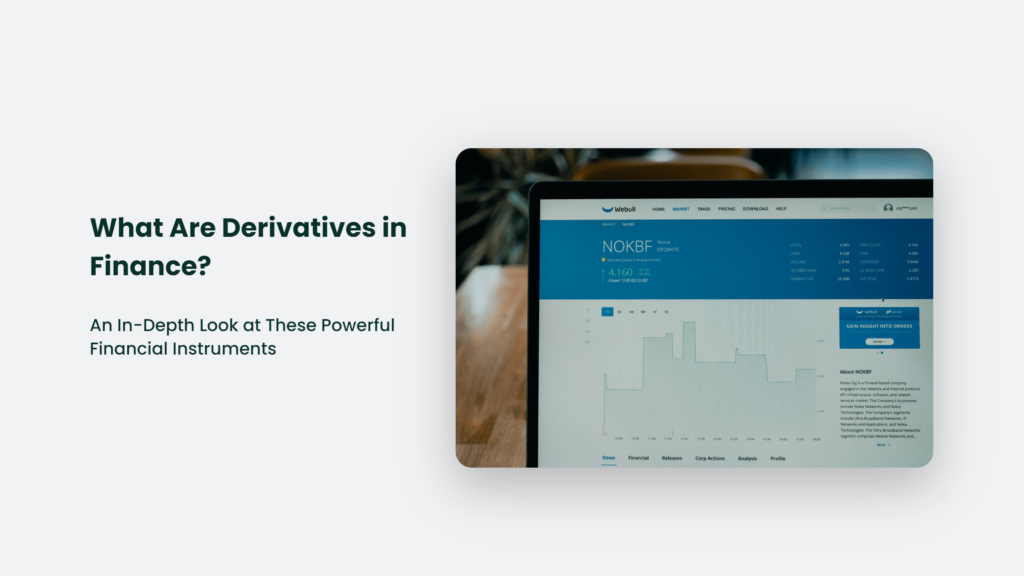

What Are Derivatives in Finance? An In-Depth Look at These Powerful Financial Instruments

As Seen On
Derivatives.
The word itself sounds scary, like something you’d encounter in a calculus classroom or Wall Street boiler room. But derivatives aren’t nearly as perplexing or dangerous as their reputation suggests.
At their core, derivatives are simply financial contracts that derive their value from an underlying asset. This underlying asset can be a commodity, currency, bond, stock, or even an interest rate. Derivatives allow investors to speculate on the future price movements of the asset or hedge against risk.
Now that we’ve defined what derivatives are in plain English let’s dive deeper into the intricacies of these powerful financial tools. Here’s a derivatives crash course for both newbies and seasoned investors alike.

What Are Derivatives in Finance?
Humans have been using primitive derivative contracts for centuries. In the 1600s, rice futures contracts were developed in the Dojima Rice Exchange in Japan. Farmers and merchants could agree on a fixed future price for rice, helping both parties hedge against volatile price swings.
But derivatives really took off in the 1970s, as the end of the Bretton Woods system and the 1973 oil crisis created currency and commodity volatility. New derivative products like currency and oil futures helped corporations manage this new risk.
In the 1980s and 1990s, derivatives exploded in popularity due to deregulation and financial engineering. Exotic derivatives like credit default swaps and collateralized debt obligations played a central role in the 2008 financial crisis.
However, when used properly, derivatives continue to serve a valuable role in risk management and price discovery. They aren’t going away anytime soon.
The Four Main Types of Derivatives
There are four primary types of derivatives:
Futures
A futures contract obligates the buyer to purchase an asset at a predetermined future date and price. It’s similar to a forward contract, except futures are standardized and traded on an exchange.
Futures are commonly used for commodities like gold, oil, and agricultural products. But there are also futures on financial assets like stocks, bonds, and currencies.
For example, an oil producer could use crude oil futures to lock in a selling price for their future production. It protects them from falling oil prices.
Forwards
Forward contracts are similar to futures, but they are non-standardized and traded over the counter. The added flexibility makes forwards popular for hedging foreign currency risk.
For example, a European exporter receiving payment in US dollars could enter a forward contract to sell those dollars in the future at a set Euro exchange rate. It insulates them from potential drops in the Euro/USD rate.
Options
Options give the buyer the right, but not the obligation, to buy or sell the underlying asset at a set price on or before a future expiration date. Calls provide the right to buy, while puts provide the right to sell.
Options can be used to speculate on asset prices. But they also provide flexible hedging opportunities not offered by futures and forwards.
For example, a farmer could buy corn-call options to guarantee a future selling price while retaining the ability to sell at market prices if corn prices rise.
Swaps
Swaps are derivatives that exchange the cash flows between two parties. Interest rate swaps are the most common type, allowing parties to exchange fixed and floating interest rate payments.
For instance, a company paying floating-rate debt could swap to fixed-rate payments to protect against rising interest rates. Meanwhile, the counterparty with fixed-rate debt can swap to floating to benefit if rates fall.
How Do Derivatives Work? The Long Story Made Short
Now that we’ve covered the main derivative types let’s examine how they actually work in more detail.
At expiration, financial derivatives settle based on the price of the underlying asset relative to the derivative contract terms. Settlement can occur by physical delivery of the asset or a cash payment.
For example, say a gold futures contract has a futures price of $1,700 per ounce. At expiration, if the spot price of gold is $1,800, the seller must pay $100 per ounce to the buyer since the market price exceeds the futures price.
Derivatives get their value from the future price movements of the underlying. A futures price above the spot price indicates an expected increase in the asset’s value. It causes the derivative to trade at a premium to the spot.
Conversely, if futures trade below the spot, the derivative trades at a discount, indicating an expected decline in the underlying asset before expiration.
Options have a more complex payout but also gain value based on the amount the spot price moves relative to the option’s strike price. More movement equals higher profits.
Why Do People Use Derivatives?
There are two primary reasons investors use derivative contracts:
Speculation: Derivatives like futures, options, and swaps can be used to profit from an asset’s price movements without owning the underlying asset. These leveraged bets provide opportunities for potentially huge gains (and losses).
Hedging: Derivatives can also be used to reduce risk by locking in prices for future buying or selling. It protects against unfavourable price swings that could harm an investor’s position.
Here are some examples of how investors use derivatives to speculate and hedge:
- A commodity trader buys crude oil futures because she expects oil prices to rise. She profits if her prediction holds true.
- A corporation facing currency risk buys put options on the Euro to hedge against the Euro depreciating versus the US Dollar. The downside is limited.
- An interest rate swap allows a company to switch from variable rate debt to fixed rate. This locks in low rates and provides stability.
- A speculator buys S&P 500 call options, betting on a rise in stock prices. His loss is limited to the premium paid.
As you can see, derivatives provide a myriad of ways to implement speculative strategies or reduce portfolio risk.
Derivatives Pros and Cons: A Balanced Perspective
Derivatives, like anything in finance, have their downsides. Critics argue derivatives:
- Are complex and prone to misuse
- Increase systemic risk and volatility
- Lack of transparency and regulation
However, when used appropriately, derivatives offer significant advantages:
Hedging
- Mitigate portfolio risk and stabilize returns
- Lock in attractive prices for future transactions
Speculation
- Provide leveraged exposure to asset prices
- Allow profits from accurate forecasts
Price Discovery
- Help discover fair value of underlying assets
- Increase market information and efficiency
The key is understanding how derivatives work and using them responsibly. With proper risk management, they provide useful tools for investors and corporations.
Frequently Asked Questions:
What is a derivative crash or blowup?
This occurs when large, unexpected derivative losses destabilize a financial institution or the broader markets. Recent examples include Long Term Capital Management in 1998, AIG in 2008, and Archegos Capital in 2021.
Which companies trade the most derivatives?
Banks like JPMorgan, Goldman Sachs, and Morgan Stanley dominate global derivatives dealing and trading. Other active participants include hedge funds, pension funds, insurers, and corporations.
Are derivatives risky?
Derivatives carry risks like volatility, leverage, counterparty credit risk, and improper usage. But used properly for hedging, derivatives reduce risk. Speculators take on added risks in exchange for profit potential.
The Final Word on Derivatives
Derivatives remain controversial but essential elements of the modern financial system. By providing leverage, speculation, and hedging tools, they help investors implement complex strategies.
However, derivatives come with distinct risks and must be used with care and wisdom. A strong understanding of their benefits and dangers is required.
At their best, derivatives foster price discovery, risk transfer, and market efficiency. When misused, they can drive instability and blowups. Mastering derivatives provides great power but also demands great responsibility.
Konger
Up until working with Casey, we had only had poor to mediocre experiences outsourcing work to agencies. Casey & the team at CJ&CO are the exception to the rule.
Communication was beyond great, his understanding of our vision was phenomenal, and instead of needing babysitting like the other agencies we worked with, he was not only completely dependable but also gave us sound suggestions on how to get better results, at the risk of us not needing him for the initial job we requested (absolute gem).
This has truly been the first time we worked with someone outside of our business that quickly grasped our vision, and that I could completely forget about and would still deliver above expectations.
I honestly can't wait to work in many more projects together!
Disclaimer
*The information this blog provides is for general informational purposes only and is not intended as financial or professional advice. The information may not reflect current developments and may be changed or updated without notice. Any opinions expressed on this blog are the author’s own and do not necessarily reflect the views of the author’s employer or any other organization. You should not act or rely on any information contained in this blog without first seeking the advice of a professional. No representation or warranty, express or implied, is made as to the accuracy or completeness of the information contained in this blog. The author and affiliated parties assume no liability for any errors or omissions.

